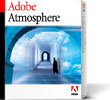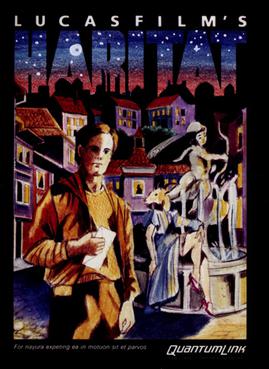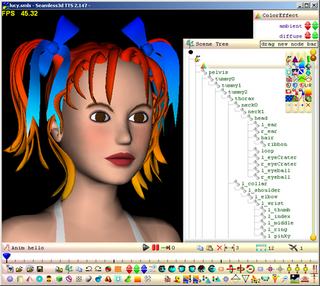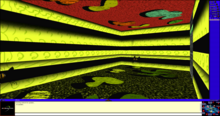
VRML is a standard file format for representing 3-dimensional (3D) interactive vector graphics, designed particularly with the World Wide Web in mind. It has been superseded by X3D.

Second Life is an online multimedia computing platform that allows people to create an avatar for themselves and then interact with other users and user-created content within a multi-user online virtual world. Developed and owned by the San Francisco–based firm Linden Lab and launched on June 23, 2003, it saw rapid growth for some years and in 2013 it had approximately one million regular users. Growth eventually stabilized, and by the end of 2017, the active user count had fallen to "between 800,000 and 900,000". In many ways, Second Life is similar to massively multiplayer online role-playing games; nevertheless, Linden Lab is emphatic that their creation is not a game: "There is no manufactured conflict, no set objective."

Adobe Atmosphere was a software platform for interacting with 3D computer graphics. 3D models created with the commercial program could be explored socially using a browser plugin available free of charge. Atmosphere was originally developed by Attitude Software as 3D Anarchy and was later bought by Adobe Systems. The product spent the majority of its lifetime in beta testing. Adobe released the last version of Atmosphere, version 1.0 build 216, in February 2004, then discontinued the software in December that year.

Active Worlds is an online virtual world, developed by ActiveWorlds Inc., a company based in Newburyport, Massachusetts, and launched on June 28, 1995. Users assign themselves a name, log into the Active Worlds universe, and explore 3D virtual worlds and environments that others have built. ActiveWorlds allows users to own worlds and universes, and develop custom 3D content. The browser has web browsing capabilities, as well as voice chat, and basic instant messaging features.

Habitat is a massively multiplayer online role-playing game (MMORPG) developed by LucasArts. It is the first attempt at a large-scale commercial virtual community that was graphic based. Initially created in 1985 by Randy Farmer, Chip Morningstar, Aric Wilmunder and Janet Hunter, the game was made available as a beta test in 1986 by Quantum Link, an online service for the Commodore 64 computer and the corporate progenitor to AOL. Both Farmer and Morningstar were given a First Penguin Award at the 2001 Game Developers Choice Awards for their innovative work on Habitat. As a graphical MUD it is considered a forerunner of modern MMORPGs unlike other online communities of the time. Habitat had a GUI and large user base of consumer-oriented users, and those elements in particular have made Habitat a much-cited project and acknowledged benchmark for the design of today's online communities that incorporate accelerated 3D computer graphics and immersive elements into their environments.

Microsoft V-Chat is a freeware 3D chat program released in December 1995 by Microsoft. V-Chat is a multi-user social chat client that lets people interact online from within a 2D or 3D multimedia environment using graphical representations of themselves known as avatars. V-Chat avatars have a full range of gestures that allow users to fully express themselves online. V-Chat enables users to select from a wide variety of existing avatars, or create custom avatars using the V-Chat Avatar Wizard. Sounds, animations, and visual imagery create mood and context for these graphical social environments.
Open Wonderland is an open-source toolkit written in Java for creating collaborative 3D virtual worlds. Within those worlds, users can communicate with high-fidelity, immersive audio, share live desktop applications and documents in addition to conducting real business. Open Wonderland is completely extensible; developers and graphic artists can extend its functionality to create entirely new worlds, including but not limited to adding new features to existing worlds.

Seamless3d is an open-source 3D modeling software available under the MIT license.
Ai Space is a Japanese virtual 3D massively multiplayer online social game (MMOSG) developed by several companies that formed the Ai Space Production Committee which was launched on October 15, 2008 for Windows PCs, despite an earlier announcement of a Q3 2008 release. Beta testing commenced between mid-September and mid-October 2008. Primary development was handled by Headlock, and Dwango provided the world's infrastructure and Internet service. Dwango's subsidiary Niwango tied in the Nico Nico Anime Channel from the Nico Nico Douga video sharing website which provided users the opportunity to upload gameplay sequences online. The game closed down on June 30, 2011.
Cyberformance refers to live theatrical performances in which remote participants are enabled to work together in real time through the medium of the internet, employing technologies such as chat applications or purpose-built, multiuser, real-time collaborative software. Cyberformance is also known as online performance, networked performance, telematic performance, and digital theatre; there is as yet no consensus on which term should be preferred, but cyberformance has the advantage of compactness. For example, it is commonly employed by users of the UpStage platform to designate a special type of Performance art activity taking place in a cyber-artistic environment.

CyberTown (CT) was an online virtual world. There were places available either through a 2D or 3D chat environment. Users were able to have jobs within the community, earning virtual money called CCs (CityCash) that could be used to buy 3D homes and items. Each user was allowed a free 2D home and could locate it within any of a number of colonies subdivided into neighborhoods and blocks. The cost was $5.00 per month or $49.99 a year.

Blue Mars, a 3D massively multiplayer virtual world platform developed by Hawaii-based Avatar Reality, allows 3rd parties to create virtual worlds, MMOG games, simulations, shops, businesses, entertainment venues, clothing, custom avatars, furniture, virtual homes, and other items. It consists of four main parts: the client software, the Sandbox Editor SDK suite, the website, and the host servers. It is often compared to Second Life, since both are virtual social worlds allowing user-created content. According to Jim Sink, CEO of Avatar Reality, "Blue Mars was inspired by a vision of the future when the power to terraform whole worlds is within our grasp. The name Blue Mars represents possibility and hope."

Open Cobalt is a free and open-source software platform for constructing, accessing, and sharing virtual worlds both on local area networks or across the Internet, with no need for centralized servers.

Tony Parisi, one of the early pioneers in virtual reality and the metaverse, is an entrepreneur, inventor and developer of 3D computer software. The co-creator of Virtual Reality Modeling Language (VRML), he has written books and papers on the future of technology. He works on WebGL and WebVR and has written two books on the former, and an introductory book on virtual reality programming. He is the chief strategy officer at Lamina1. Parisi is also a musician, composer and producer working on multiple projects.

Blaxxun Interactive, originally named "Black Sun Interactive", was one of the first companies to develop a 3D community platform designed for the Internet using VRML and highly scalable multi-user server environments.
OZ Virtual was a 3D world viewer created by OZ Interactive that enabled real-time collaboration communications in shared spaces on the Internet with a strong focus on creative content production.
The virtual world framework (VWF) is a means to connect robust 3D, immersive, entities with other entities, virtual worlds, content and users via web browsers. It provides the ability for client-server programs to be delivered in a lightweight manner via web browsers, and provides synchronization for multiple users to interact with common objects and environments. For example, using VWF, a developer can take video lesson plans, component objects and avatars and successfully insert them into an existing virtual or created landscape, interacting with the native objects and users via a VWF interface.

Tamiko Thiel is an American artist, known for her digital art. Her work often explores "the interplay of place, space, the body and cultural identity," and uses augmented reality (AR) as her platform. Thiel is based in Munich, Germany.
Starbright World was an online community for children with chronic illnesses established in 1995. Initially conceived as a 3D virtual world for use in hospitals, it was developed by Worlds Inc. for the Starbright Foundation. The 3D world―credited as one of the first applications of virtual reality in medicine―operated until 1997, when it was shut down due to technical issues. In 1998, it was replaced with a private social network, which is now defunct. Worlds Inc. would later launch lawsuits against several massively multiplayer online game companies, claiming that they held the rights to the concept of multiplayer virtual worlds based on patents obtained in relation to Starbright World.

SAPARi (さぱり) was an online 3-D virtual world service developed in Java and run by Sony. Users could speak to one another and join chat lobbies by using a dedicated server browser called the Community Place Browser. Upon selecting a server, users would appear in a 3-D virtual world as an avatar in the form of a human or an animal. The service's name is a shortening of the name Sampo Park Relaxation. From 1997 to 2001, the service came pre-installed on Sony's VAIO series of computers. The official SAPARi service was discontinued on January 31, 2003.













